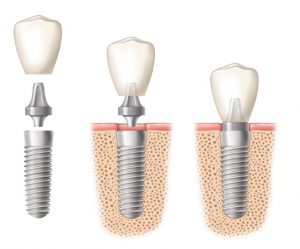Header logo
header top contact widget
Tooth Replacement
Missing Teeth Should Be Replaced For The GOOD Of Overall Well-Being.
Posted on Oct 22, 2019 by William J. Claiborne, DDS MS
Sometimes, it’s what we can’t see that can do the most harm.
A surprising example of that is wearing dentures. While dentures and partial dentures do replace the presence of teeth, they actually have a detrimental effect on what lies beneath.
If you remove your denture, you can actually SEE what’s going on.
For people who have worn dentures or partials for ten years or more, the appliance has applied pressure to the bone ‘ridge’ that once supported natural teeth. And, without the stimulation of tooth roots in the bone, the jaw begins to decline in mass.
Without the denture in place to “fluff up” the shape of the mouth, a look in the mirror can reveal signs of bone loss. These include:
- Deep wrinkles around your mouth.
- The corners of your mouth turn downward, even in a smile.
- The mouth seems sunken in. Jowls have formed on the sides of the face.
- The chin seems more pointed than in your youth.
- The chin may also seem closer to the nose.
This decline in bone occurs when a tooth root is removed from the jaw bone. Without natural tooth roots to nourish and stimulate the root, the process of ‘resorption’ begins.
Additionally, resorption increases risks for tooth loss to neighboring natural teeth. As the jaw bone declines in an area to adjacent tooth roots, these teeth are more vulnerable to cavities, gum disease, and fractures.
It is a fact that when a tooth is lost, the one next to the one missing is most likely the next to be lost.
For people who opt to replace a tooth (or teeth) with a crown-&-bridge, they can also expect bone loss. Over time, this is visible by a gap that seen between the base of the bridge and the natural gum tissues.
As a periodontist, the most common complaint I hear from those who wear dentures or partials is having discomfort while eating. Many long-time denture and partial wearers experience sore spots on tender gum tissues. This occurs because their appliances move when chewing certain foods.
This movement is the result of the declined bone mass that supports the denture. This gum-covered ‘ridge’ where teeth were once held flattens as the jaw bone declines in height and mass. Because a denture or partial is made to contour to this ridge, it begins to slip as the bone shrinks. This is when people tend to use denture adhesives and pastes more frequently.
To avoid discomfort when eating, denture wearers begin to alter their food selections, opting for soft foods that dissolve quickly in the mouth without having to chew. In many cases, these choices lack the fiber, vitamins, minerals and protein needed for proper nutrition.
To no surprise, denture wearers are known to take more medications and have more gastrointestinal problems than non-denture wearers. Yet, the problems of “slippery” or “wobbly” dentures can affect social involvement as well.
Due to fear of embarrassing slips, denture wearers begin to decline social gatherings where food is the centerpiece. Social involvement is a healthy part of keeping our brains and bodies active, which is a positive part of aging.
It stands to reason that there is a need to replace more than the mere presence of teeth. This is why so many dentists and dental specialists now recommend dental implants. For decades now, they have been a dependable option to replace missing natural teeth.
There are many advantages to dental implants. From a health standpoint, I see their ability to halt bone loss as a leading benefit. Dental implants are placed in the jaw bone, recreating the stimulation of tooth roots. This helps to preserve the strength of the jaw bone while restoring biting strength and chewing stability.
I also like that dental implants are self-supporting since they use the jaw bone for support. They do not rely on having otherwise-healthy, natural teeth crowned for the mere purpose of supporting replacement teeth (as in crown-&-bridge combinations).
From a value perspective, dental implants are an excellent investment. With proper selection, placement and care, they are designed to last your lifetime. And, it’s an investment you’ll enjoy every day as you comfortably eat foods you love, smile and laugh without worry, and wake up with a smile!
There is much to know as to why keeping your natural teeth is so important. However, when tooth loss does occur, you can protect your health and well-being by replacing them with implants. With dental implants, you are able to avoid the long-term repercussions of bone loss.
When extreme bone loss has occurred, we can restore bone mass through several methods. One uses a bone-rebuilding material that generates new growth. For some patients who have lost bone due to gum disease, our Asheville periodontal dental office also offers LANAP technology (Laser-Assisted New Attachment Procedure). This advanced technology has been found to stimulate bone regrowth in damaged areas.
Ask about dental implants to restore a natural look and feel while you protect surrounding teeth and bone structure. As a periodontist with advanced training in the diagnosis and placement of all types of implant systems, I can recommend options that will work best for your individual situation.
Call 828-274-9440 to learn more or ask for a consultation to personally discuss your needs and preferences.
Know The Unseen Risks Of Wearing Dentures
Posted on Sep 19, 2019 by William J. Claiborne, DDS MS
As an Asheville periodontist, my goal is to provide each patient with the very best so they can enjoy a healthy, confident smile. For patients who have lost one or more natural teeth, some come to me because they want to avoid ending up having to wear a full or part ial denture. For those who wear one and are unhappy with the feel and function, we are sought out as specialists in the diagnosis and placement of dental implants.
ial denture. For those who wear one and are unhappy with the feel and function, we are sought out as specialists in the diagnosis and placement of dental implants.
Denture wearers, especially those who have worn dentures for many years, can quickly become dissatisfied with the uncomfortable rubbing and difficulty eating foods they once enjoyed. Although their ‘appliance’ may have fit well when first made, changes in the fit, over time, are due to what is taking place below the gum tissues. These changes aren’t obvious, at first.
When first made, a denture is custom-designed to fit snugly to the unique contours of the gum ridge. This ‘ridge’ is the raised arch where natural teeth were once held. Over time, denture wearers begin to notice that the denture moves while chewing certain foods. This can rub sore spots on gums. As the denture loosens more, even using denture adhesives or pastes don’t help much.
Denture patients also learn that it can be painful for something as small as a sesame seed to become trapped between their denture and gums, piercing into tender gum tissues. Some people eventually switch to a diet of soft foods that dissolve easily to avoid rigorous chewing. Because of fear of embarrassing slips, others begin to decline social invitations when they are centered around food.
The problem for a denture wearer is what is happening underneath the gums. The looser fit is not because the denture has expanded – it’s the decline of the jaw bone. This occurs with the absence of tooth roots, which once provided nourishment and stimulation to the bone that supported them.
When natural tooth roots are removed, the jaw bone begins to shrink. This decline in bone mass also contributes to changes in facial appearance, such as deep wrinkling around the mouth and the formation of jowls.
The process of bone loss continues as the gum ridge your denture was contoured to flattens. Relines may temporarily adjust the denture to accommodate some of the change. However, as the jaw bone continues to decline, the denture continues to be difficult to keep in place.
The denture itself merely adds to the problem of bone loss. The pressure of wearing a denture actually accelerates the rate of bone loss. Since a number of denture wearers also sleep in their dentures, the 24/7 pressure speeds this rate even more.
Long-time denture wearers often complain that they are not able to chew, with some admitting they have to even remove their denture to eat. Fear of embarrassment is another common complaint. Speaking, laughing and even sneezing in the presence of others can create embarrassing moments that leave lasting impressions.
The solution to these problems – dental implants. Not only do implants restore the ability to bite and chew comfortably, they halt bone loss that is associated with dentures. Because they are held by the jaw bone, just as natural tooth roots once were, implants recreate the stimulation needed by the jaw bone to maintain its mass.
Does your denture bring to mind words like rocky, wobbly and slippery? If so, the problem will only worsen over time. When people choose dental implants to replace an ill-fitting denture, they can smile, laugh and chew with confidence.
Eating a healthy diet, socializing with friends and family, and feeling confident are essential to a healthy, happy life. Call our friendly Asheville periodontal dental office: 828-254-9440 to schedule an initial appointment. (A referral is not required). During this time, I’ll explain the type of implants that may be best for your needs as well as comfort options, including oral and IV sedation (“twilight sleep”). We are also happy to discuss estimated costs and payment options.
React To Gum Disease EARLY To Save Time & Money On Treatment.
Posted on Aug 08, 2019 by William J. Claiborne, DDS MS
“Hindsight is 20-20.”
This saying describes how, if we’d “known then what we know now…” we may have taken a different course of action for a better outcome.
In cases where gum disease develops or tooth loss occurs, patients often wish they could turn back the hands of time. Many patients who have acquired gum disease or had teeth replaced because of it are now highly-committed to their oral health. They often tell us, “I wish I’d taken better care of my mouth before,” now realizing how problems can be avoided as well as the benefits of good oral health.
Periodontal (gum) disease and (often) its subsequent tooth loss are, simply put, products of bacterial overload in the mouth. Our mouths are constantly being supplied with sustenance for these organisms. Bacteria are able to thrive through food that enters, especially sugars, and other bacteria-laden items put into the mouth. As bacteria thrive, they are able to reproduce very rapidly.
When bacteria levels become more than the immune system can tackle, infection can set in. Just as a cut or scrape on the skin that is not kept sufficiently clean can become infected, oral bacteria can cause an infection to develop in the mouth. This accumulation of bacteria can evolve into gum disease, which is an inflammation that attacks teeth, oral tissues and the bone structures that support tooth roots.
Gum disease symptoms include sore gums that bleed when brushing, frequent bad breath, gums that pull away from the base around teeth, gums that darken in color. As it worsens, pus pockets may form on the gums at the base of some teeth. In advanced stages, gum disease causes teeth to loosen and eventually require removal.
Gum disease often progresses because people are unaware that bleeding or receding gums is actually a symptom. Insufficient brushing, failing to floss and not having regular dental cleanings form a path that begin the process.
Insufficient care can lead to a build-up of bacteria, known as plaque. Plaque is a sticky (or “fuzzy”) film you feel on teeth when not removed on a regular basis. In just 48 hours, plaque can transform into a cement-hard colony of oral bacteria that attaches to teeth. This hardened form of bacteria is known as tartar or calculus. Unlike plaque, tartar cannot be brushed or flossed away.
As your mouth is enduring the repercussions of oral bacteria accumulation, gum tissues and tooth enamel are attacked. Once this infectious bacteria has penetrated below the gum line, dental treatment is necessary to halt its continued development and restore healthy gums
With prompt and proper measures, however, you can halt and reverse the need for dental treatment and avoid the repercussions of gum disease.
Gingivitis is the initial stage of gum disease. Symptoms typically include gums that are tender in spots and some bleeding when you brush. These are warning signs that signal an immediate need for attention.
Begin by twice daily brushing with a soft bristle tooth brush and use a fluoridated tooth paste. Brush for at least two minutes each time. Floss daily. Be sure not to pop the floss between teeth to avoid damaging tender gums. Move the floss in a back-&-forth motion between teeth to ease it down so you can scrape the sides of each tooth.
You can remove a tremendous amount of oral bacteria by using a tongue scrapper daily. Or, brush your tongue with your tooth brush at the end of each brushing. This helps to dislodge bacteria that is embedded in the grooves of the tongue.
Drink lots of water during the day. This will help keep saliva flow at ample levels. Saliva is designed to move oral bacteria from the mouth on a consistent basis. Oral dryness is the enemy. Avoid foods and beverages that are drying to oral tissues such as caffeine, alcohol, and spicy foods. Also, try to minimize the amount of sugar and carbohydrates you consume. These foods amplify the reproduction of oral bacteria.
If you smoke, consider using an oral rinse that replenishes moisture in the mouth. The chemicals in cigarette smoke are verey drying to oral tissues. Some oral rinses are specifically designed for producing moisture. Remember, oral dryness gives bacteria a favorable environment for reproduction.
When it comes to the initial formation of gingivitis, these steps will help relieve gum tenderness and potential to bleed within a week or so. If you do not see improvement after 2 weeks of diligent measures, see a periodontal specialist as soon as possible.
A periodontist is a dental specialist who can determine your precise level of gum disease and the most appropriate treatment to restore good oral health.
Call 828-274-9440 if you have questions about your gums or if you are experiencing any symptoms associated with gum disease.
Dental Implants – Many Types Available For Different Needs & Preferences
Posted on Jul 10, 2019 by William J. Claiborne, DDS MS
As a periodontist, an area of my dental specialty includes advanced training in the diagnosis and placement of dental implants. This specialized expertise provides implant patients with a high level of success in treatment outcome. It also offers patients a wider variety of choices when it comes to implant systems.
When dental offices offer dental implants, some general dentists refer the placement portion to a periodontal specialist. For their patient, this can mean a higher level of success, especially for complex needs.
For example, a patient who is missing a lot of bone mass (often due to missing natural teeth for many years) benefits from the specialized skills of our Asheville periodontal office. Another example is a patient who has lost teeth due to periodontal (gum) disease. Because a periodontist combines advanced skills in treating gum disease as well as in dental implants, these patients are given a ‘leg up’ when it comes to treatment success.
Dental implant diagnosis and placement skills can vary greatly when offered by general dentists. While some have taken extensive courses in implant dentistry, others may have taken a weekend course here and there. These are typically ‘hosted’ by a particular manufacturer who provides ‘training’ in a limited selection of implant types. In turn, this can limit the patient’s choices when relying on appropriate recommendations for his or her unique needs.
Now seen as the preferred option for tooth replacement, dental implants are available to accommodate various challenges and preferences. There are numerous choices available. Some of the more common include:
Traditional Dental Implants: In this process, dental implants includes a couple of stages. Implant placement is performed first. This involves small incisions in pre-selected placement points. These points are determined through computerized imaging, taking the guesswork out of the depth and angle of each implant placed. Once the implant is in proper position, the gum tissue is closed over the implant sites.
For a ‘healing period’ of 3-6 months, the bone grows around the implants to secure each in place. This process is referred to as ‘osseo-integration,’ which describes the bone growing around the implanted portion. The process is similar to a rope tied around the branch of a tree. Over time, the branch grows around the rope. Osseo-integration is similar to this but occurs at a much more rapid pace.
After several months, the implant sites are uncovered and a post is positioned inside each implant. Onto the posts, the replacement teeth are secured. Rest assured, during the healing phase, patients are able to wear their denture or partial comfortably. Once the final teeth are attached, patients can enjoy their ‘new’ smile along with the biting and chewing comfort like that of natural teeth.
Non-Removable Teeth Attached To Implants: In the past, the more affordable ‘full arch’ systems were typically those designed to support removable teeth. (An ‘arch’ replaces all upper or all lower teeth.) However, some people feel removable teeth are too similar to the denture they have (and detest). Although firmly secured, the chore of having to remove their new teeth to clean is undesirable to many people.
A number of implant systems are available, designed to provide non-removable options that are more affordable. For example, the All On 4 dental implant system is made to support non-removable teeth, often on just 4 implants. With the implanted portions placed at unique angles, these longer implants can fully distribute biting and chewing forces.
Another advantage of All On Four is their ability to be placed in minimal bone. This is good news for people who are long-time denture wearers and were told they have too little bone to support implants. Or, they may have been advised to have bone grafts to rebuild the bone to an adequate height. This adds time and expense to implant treatment. Often, the All On 4 design is able to overcome this obstacle.
‘Same-Day’ Dental Implants: With advanced implant systems and technology, implant placement and teeth attachment can be accomplished in a single day. Advanced implant designs can position implants in the jaw bone that are ready to support replacement teeth. With the replacement teeth created prior, the teeth may be attached without delay. In some cases, a previously-made denture or partial can be reconfigured to attach to newly placed implants. “Implants in a day” isn’t wise for all situations, however. This option should be diagnosed and performed by a skilled, experienced professional who understands both the requirements and limitations involved. Putting your care in the hands of an experienced, skilled and highly-trained dental specialist is the best way to achieve a successful outcome. Just a note – while these quick-&-easy procedures can sound appealing, be cautious of ‘clinic’ settings who promote same-day implants. For an optimal outcome, choose care where your individual needs are a priority, rather than corporate profit goals.
Modern implant dentistry is successful, safe, dependable and can provide nearly immediate benefits. As a dental specialist who has stayed on the cutting edge of implant dentistry’s techniques, technology and materials, I am pleased to witness the transformations our patients undergo after treatment.
Dental implants are designed to last a lifetime and the closest thing to the natural teeth you once had. Too, the restored ability to bite, chew, speak and laugh confidently and even sneeze without worry can provide a tremendous boost to one’s self-esteem, self-confidence.
The type of dental implant best suited for you can be determined after an examination and review of x-rays (we use Cone-Beam digital imaging). Call 828-274-9440 to begin with a private, no obligation consultation to discuss your best options.
Recent Posts
Categories
Archives
- September 2024
- August 2024
- July 2024
- June 2024
- May 2024
- April 2024
- March 2024
- February 2024
- January 2024
- December 2023
- November 2023
- October 2023
- September 2023
- August 2023
- July 2023
- June 2023
- May 2023
- April 2023
- March 2023
- February 2023
- January 2023
- December 2022
- November 2022
- October 2022
- September 2022
- August 2022
- July 2022
- June 2022
- May 2022
- April 2022
- March 2022
- February 2022
- January 2022
- December 2021
- November 2021
- October 2021
- September 2021
- August 2021
- July 2021
- June 2021
- May 2021
- April 2021
- March 2021
- February 2021
- January 2021
- December 2020
- November 2020
- October 2020
- September 2020
- August 2020
- July 2020
- June 2020
- May 2020
- April 2020
- March 2020
- February 2020
- January 2020
- December 2019
- November 2019
- October 2019
- September 2019
- August 2019
- July 2019
- June 2019
- May 2019
- April 2019
- March 2019
- February 2019
- January 2019
- December 2018
- November 2018
- October 2018
- September 2018
- August 2018
- July 2018
- June 2018
- May 2018
- April 2018
- March 2018
- February 2018
- January 2018
- December 2017
- November 2017
- October 2017
- September 2017
- August 2017
- July 2017
- June 2017
- May 2017
- April 2017
- March 2017
- February 2017
- January 2017
- December 2016
- November 2016
- October 2016
- September 2016
- August 2016
- July 2016
- June 2016
- May 2016
- April 2016
- March 2016
- February 2016
- January 2016
- December 2015
- November 2015
- October 2015
- September 2015
- August 2015
- July 2015
- June 2015
- May 2015
- April 2015
- March 2015
- February 2015
- January 2015
- December 2014
- November 2014
- October 2014
- September 2014
- August 2014
- July 2014
- June 2014
- May 2014
- April 2014
- March 2014
- February 2014
- January 2014
- December 2013
- November 2013
- October 2013
- September 2013
- August 2013
- July 2013
- June 2013
- May 2013
- April 2013
- March 2013
- February 2013
- January 2013
- December 2012
- November 2012
- October 2012
- September 2012
- August 2012
- July 2012
- June 2012


